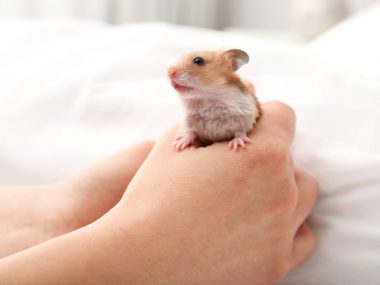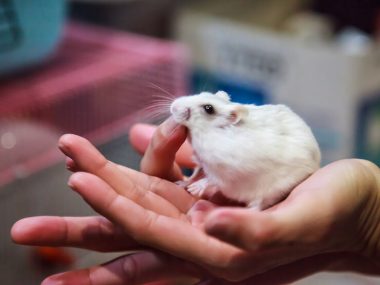Some people say hamsters need friends; others say they are loners and will kill each other but which opinion is correct? We have scoured the research studies on hamster sociability to provide you with a clear data-backed answer as to whether hamsters get lonely.
Scientists, hamster breeders, and experienced owners agree that most hamsters do not get lonely and happily live alone. However, some hamster species will tolerate living in a same-sex group cage. New research has shown that female Syrian hamsters may be more anxious if housed alone.
You love your little furball and want the best for your tiny pet, and you might feel tempted to buy a friend for your “lonely” hamster. However, is this wise? Does your hamster want a friend, or does it prefer having all that prime cage space to itself?
Table of Contents
Do Scientists Believe Hamsters Get Lonely?
Determining whether a hamster is lonely or not is a challenge as we cannot ask them about their feelings. Instead, scientists must “guess” whether the hamster is lonely based on their behaviors and stress responses when kept alone versus when they are kept in pairs or groups.
In addition to being excellent pets, hamsters (especially Syrian hamsters) are commonly used as laboratory animals.
The widespread use of hamsters as laboratory animals meant that scientists had plenty of opportunities to theorize about the sociability of hamsters.
Historically, scientists believed that hamsters were asocial creatures, i.e., preferring to avoid social contact. It was thought that hamsters lived solitary lives, occupying burrows and viciously defending their home territory from trespassing hamsters.
Previous studies indicated that hamsters housed together showed behavioral and physiological stress responses following aggressive encounters between cage mates.
As a consequence of these observations, it was concluded that hamsters do not get lonely, are not social, and cannot be housed together. However, research conducted in the past decade (2014 and 2017) has questioned the validity of this long-held belief on hamster sociability.
A Revolutionary Study Proves Female Hamsters Can Get Lonely
In previous studies, female hamsters housed in group cages showed increased cortisol levels (i.e., one of the stress hormones), with a subsequent increase in body mass and adiposity (i.e., fat deposits).
However, in 2014 Shannonhouse et al. challenged this hypothesis when he and his colleagues studied the effects of social isolation in female Syrian hamsters.
The study found that female Syrian hamsters isolated from other hamsters demonstrated a significant increase in anxiety-linked behaviors and anorexia.
The lonely anorexic female hamsters were reluctant to eat, quickly lost weight, and showed an increase in metabolism, i.e., burnt through fat stores faster than a healthy, relaxed female hamster.

Shannonhouse et al. theorized that Syrian female hamsters show plasticity in their emotional phenotypes and bioenergetics during the pubescent phase.
A more straightforward way of saying this is that the Syrian female hamsters’ personalities and bodies change during puberty. The hamsters fluctuating hormone levels could be why previous studies showed increased cortisol levels during social interactions between adolescent hamsters.
The effects of these hormonal fluctuations on the brain are similar to those seen in human teenagers. Teenagers are notorious for their preoccupation with social interactions, social anxiety, and stress.
Adolescent female hamsters may show a temporary heightened social stress response during this growth phase. However, this social stress response decreases during adulthood.
What Other Studies (Dis)Prove That Hamsters Get Lonely?
In 2017, six scientists designed a study to investigate whether social housing impacted Syrian hamsters’ physiology.
The hamsters were assigned to one of four groups for 4 weeks:
- Females housed alone
- Males housed alone
- Female only group housing
- Male only group housing
Cortisol levels, fat pads, and thymus size were measured before and after the experiment to determine whether social housing influenced the hamsters’ wellbeing.
The hamsters had plenty of access to food and water, thus eliminating the need for the hamsters to fight over access to valuable resources.
In this experiment, the scientists found that the hamsters always fought when introducing the hamsters to each other. The fighting allowed a dominance hierarchy to be established.

Interestingly, the resident hamster always initiated the fight and successfully established dominance over the newcomer.
Despite this inauspicious beginning, the fights (in this experiment) never resulted in injury and lasted an average of 15 minutes. Once the social dominance was established, the hamsters did not engage in repeat fights.
The experiment revealed that cortisol levels amongst group-housed hamsters initially spiked before decreasing to pre-experiment levels after 2.5 weeks. Both group-housed males and females showed an increase in body fat compared to socially isolated ones.
Reduction in the mass of the thymus gland is typically associated with an increased stress response. Both male and female hamsters housed in group cages demonstrated a decrease in thymus size, although the reduction was larger in males than females.
Based on these results, the researchers concluded that Syrian hamsters tolerate social and socially isolated housing if their housing conditions are stable. However, males found group housing more stressful than females.
What Do The Results Of These “Lonely” Hamster Studies Mean?
Based on these two studies, we can conclude that hamster sociability and vulnerability to loneliness are in part gender-specific.
Syrian female hamsters are more likely to suffer from loneliness than their male counterparts. Lonely female hamsters have a higher risk of anorexia and anxiety, resulting in a compromised immune system and poor health.
Male hamsters showed a marginal preference for living alone, i.e., group-housed males had the greatest stress response.
However, the 2017 study demonstrates that Syrian hamsters can tolerate living alone or in a small group (5 or fewer hamsters) if:
- They have adequate space
- Enough water and food
- They are not housed in co-ed cages
- Their housing arrangements remain stable, i.e., hamsters are not added or removed from the cage after the initial introduction.
- Lighting conditions align with the hamsters’ circadian rhythms.
What do Hamster Experts Say About Hamster Loneliness?
Many hamster enthusiasts strongly advocate against the need for group housing, especially amongst Syrian hamsters citing past incidents where one or both hamsters were seriously injured.
However, hamster owners and breeders have noted that dwarf hamster species are more social than the territorial Syrian hamster and can be safely kept in pairs or small groups. Examples of dwarf hamsters include:
Male Chinese dwarf hamsters have been successfully housed together, although females demonstrate continued fighting regardless of how long they are kept together. Regardless of their tolerance for social housing, it is doubtful whether male or female Chinese hamsters suffer from loneliness.
Based on the advice of experts, hamsters do not experience loneliness the same way humans experience the emotion and thus do not visibly benefit from group housing arrangements.
Conclusion
Experienced hamster owners and breeders report that while dwarf hamsters can safely live in same-sex pairs or groups, Syrian hamsters should never be kept together.
These hamster experts do not believe that hamsters suffer from loneliness, and thus there is no need to risk injury by housing hamsters in group cages unnecessarily.
Contrary to this popular opinion, recent research has indicated that female Syrian hamsters may be vulnerable to loneliness and do better when kept in a socially stable group cage.
However, further research is needed to definitively determine whether ALL female Syrian hamsters do better when living in a group.
Other References
https://journals.biologists.com/jeb/article/214/7/1100/33539/Social-thermoregulation-and-torpor-in-the-Siberian






